Features, sizes and types of perforated tool panels
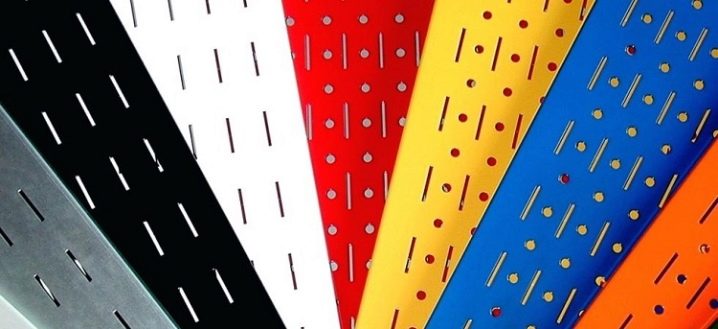
Every man tries to equip his work area in the most practical and minimalist way. Tools should always be at hand and at the same time not interfere, not accumulate in one place, for this, many owners prefer to buy or make their own special racks, cabinets, racks and instrument panels. We will talk about the latter today.
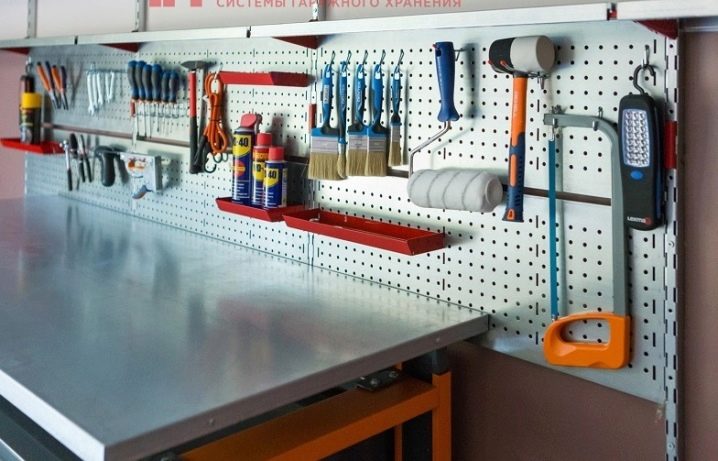
What it is?
Instrument panels are made of various materials - wood or fiberboard with drilled holes, suction cups on the wall, composite plates of ferrous or non-ferrous metal sheet with special perforations. Especially popular are metal perforated panels for storing tools. They can be purchased at any hardware store or made yourself if you love to design.
Thanks to such panels, you can compactly store all your tools and accessories, special holes are used to install hooks or fasteners for shelves for storage and quick access to certain tools. If necessary, you can attach an outlet, extension cord or charger to the panel - this is convenient when storing a power tool on it.
Such panels can be installed not only in the garage or in your workshop, for example, during repairs or construction work, spending 5 minutes on fixing the panel, all your tools will be clean and always at hand. Perforated panels have gained immense popularity not only for providing quick access to the tool, but also thanks to the saving of working space in your work area, the possibility of placing the panel above the desktop, the huge variability of fasteners and their attachment points.


Design features
Most of the perforated panels are made of aluminum or stainless steel and are painted in various colors. If you disassemble the structure in its component parts, then it consists of several main components.
The perforated panel is made of aluminum or steel, less often plastic. This is the main component; symmetrical or randomly scattered rectangular holes of the same size are made in it. Most of the panels are painted gray or white, but a colored panel can also be ordered. Aluminum is usually not painted - the material is not subject to corrosion damage. On the sides of the panel there are special stiffeners that keep the geometric dimensions unchanged under the influence of the load; on large panels, transverse and additional stiffeners are added.


For fixing the panels to the wall, special brackets are used, which are mounted into the walls by drilling or driving in. They can be replaced with anchors or ordinary dowels, onto which a block of wood is screwed first, and then the panel itself.
To fix tools, fixtures and other things, special brackets, corners and hooks are used, they are securely attached and allow you to hang tools directly on the panel or install shelves on it and put them there. Hooks are available in plastic and metal. Plastic, of course, is cheaper, but the service life and the maximum weight that they can withstand are much less, therefore it is better to initially buy metal fittings, so as not to fear for the safety of your tools and things.



Dimensions (edit)
Most of the perforated panels are made according to the so-called standard sizes, that is, templates. Basically, this is a panel length / height of 2 m and a width of 1 m.On such panels, the working space is often fenced off from the edge by several centimeters on each side, since stiffeners are installed at the edges to give strength to the structure, and they are also installed across the panel in some places. Thus, not the entire surface of the panel is perforated, but it is absolutely invisible, Since the number of perforations with a diameter of 5 to 30 mm is enormous, the diameter of the holes depends on the diameter of the wire from which the hooks or other types of fasteners are made for storing tools or other items.
For workshops or construction sites, manufacturers offer not only this size of perforated sheets, but also various variations so that each client can find the right one for him. And it is also possible from several such sheets to make one joint panel on one or more walls to save more work space.
Large areas with panels are mainly used in workshops, workshops or construction sites for easy tool storage.


Scope of application
For perforated panels, the main meaning is to store various objects or tools on them. Thus, their scope of application is multifaceted and varied - from use as shelving in a supermarket to personal workshops, everywhere they are used to store tools or objects.
In supermarkets, they fit perfectly as showcases or shelves for goods, you can often see them, for example, in the departments of perfumery, various kitchen utensils or jewelry, where the goods are attached to hooks and fasteners. Thanks to the ability to mount on the wall, they save store space, some models can be installed on special steps and carried to a place convenient for you.


In workshops or workshops, they are used both to save workspace and for the systematic and orderly storage of tools and auxiliary materials, as well as for quick access to them. Thanks to the perforated benches, the workshop work area can be divided into several areas, each of which will have its own tool stored on the panels. This is very convenient if a large workshop space does not have walls, but, for example, different people work, and to make their work more comfortable, thanks to the panels, you can make so-called cabinets for employees, or in case of undesirability of placing some units or installations, other with a friend.
Such panels are fastened mainly on anchor bolts, which are drilled into the walls, and expand there. The bolts themselves are attached to a wooden bar or metal corner, which is attached to a sheet of metal by means of self-tapping screws or dowels. This type of fastening allows you to load them with large weights, with the help of such a fastening you can store a large number of tools.
With the help of fasteners under the shelves, you can, for example, expose boxes with screws or other trifles, which also weigh a lot in aggregate. The anchorage can withstand enormous weight.

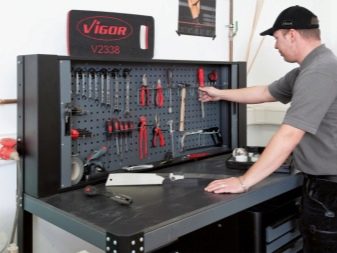
Varieties
Perforated panels are made from various materials - steel, aluminum, chipboard or plastic. Aluminum and steel panels are very popular because their service life and the loads they can withstand are many times higher than their plastic or wooden counterparts. They are not subject to corrosive effects: initially aluminum, and steel - in the case of using stainless steel or special anti-corrosion coatings. The wall-mounted metal panel is easy to install and does not require maintenance, and, which is sometimes extremely important, it is very easy to clean from oil stains or other industrial types of contamination.
The number of hooks or fasteners for the shelves is limited only by the size of the perforated stand and the number of tools or materials that need to be contained on it. Basically, manufacturers offer an extensive selection of aluminum and steel panels, now there are various solutions for sizes, configurations and external design.
If the panel is used in workshops, then the choice mainly falls on metal models.
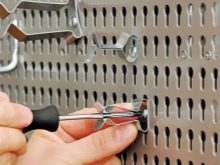


Subtleties of choice
Basically, when choosing perforated metal panels, one should be guided by the place of their application, the amount of tools or material that will be stored on them, the microclimate of the room and the issue of price and manufacturer. If your workshop has a dry microclimate, then there is no difference between the choice of aluminum or steel options for you, since the risk of corrosion is minimal.
The loads that these panels can withstand are enormous, but most steel panels are coated with a protective paint finish that also allows for color matching, which is sometimes important for the overall design of the workshop. Aluminum models are often used in supermarkets or trading floors to create racks for goods out of them.
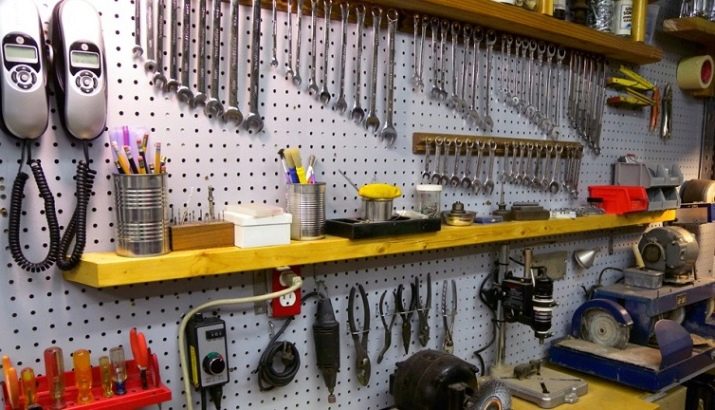





In terms of price, they differ mainly in two main parameters - this type of material and country of origin, as additional pricing criteria are complete set, color range of the panel and the number and size of perforated holes. You can choose a domestic perforated panel that will serve you faithfully, in recent years the issue of equipment has become insignificant - all manufacturers are ready to provide a huge variation of hooks, brackets and fasteners for shelves and colors.
And you can also choose a foreign analogue, for example, some of the best are Finnish ones, in which case the price will be higher, the equipment will be basically the same, except that the solutions in terms of size and color will be more variable.
For information on how to make a perforated toolbar with your own hands, see the next video.













The comment was sent successfully.